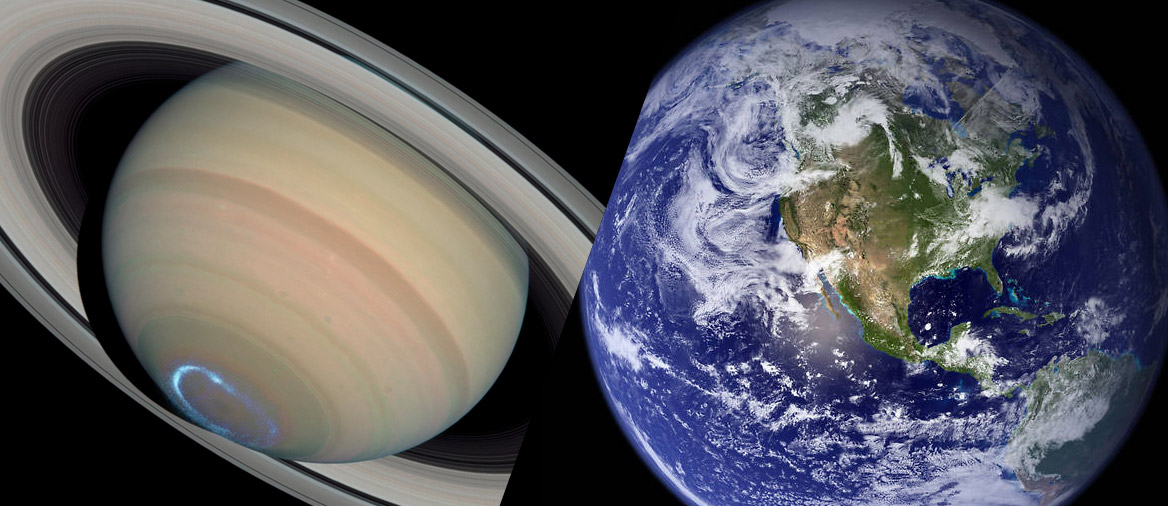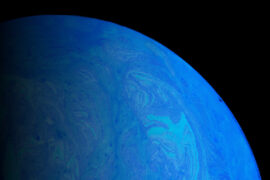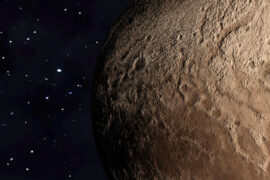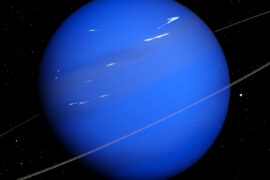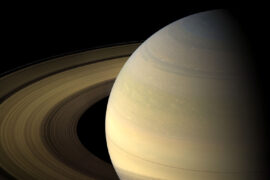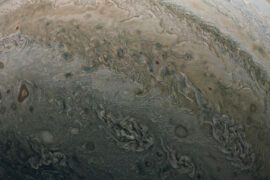Saturn is one of the coolest planets in the Solar system. And I’m not just saying that because of how amazing it looks with all its rings and pretty colors. It is literally cool with an average temperature of -220 degrees Fahrenheit (-140°C). That alone already tells us a lot about how different it is from Earth, but it is just the beginning.
The outer planets (Jupiter, Saturn, Uranus, and Neptune) are more different from Earth than the rest. They don’t even have a surface to stand on, they are huge, and their conditions are extreme.
And yet, they are still within our neighborhood, the Solar system. They must share some characteristics with our planet, right? (spoiler: they do).
In this article, we’ll take a look at the differences and similarities between Saturn and Earth. I think you will find out they have more in common than what their distinct appearances would have you believe.
Saturn vs Earth comparison
| Earth | Saturn | |
|---|---|---|
| Position in the Solar system | 3 | 6 |
| Distance from the Sun (avg) | 150 million km | 1,460 million km (1.46 billion km) |
| Radius | 6371 km | 58,232 km |
| Mass | 5.97237×1024 kg | 5.6834×1026 |
| Rotation period (1 day) | 24 h (approx) | 10.5 hours |
| Rotation speed | 0.46 km/s | 9.87 km/s |
| Orbit period (1 year) | 365 days (approx) | 29.4 years (10,759 days) |
| Orbital speed | 29.78 km/s | 9.68 km/s |
| Average temperature (outer) | 14 °C | -140 °C |
| Surface pressure | 101.325 kPa | 140 kPa |
| Surface gravity | 9.8 m/s2 | 10.44 m/s2 |
| Density | 5.52 g/cm3 | 0.687 g/cm3 |
| Escape Velocity | 11.18 km/s | 35.5 km/s |
| Albedo | 0.367 | 0.342 |
| Satellites (Moons) | 1 | 145 |
| Core | rock | rock |
| Atmosphere | 78% N, 21% O | 75% H, 25% He |
Saturn vs Earth size comparison
Saturn is much, much bigger than Earth. Its diameter is 9.1 times bigger than Earth’s, which is a big difference. When you account for that in terms of volume, it turns out that you could fit more than 700 Earths inside Saturn.
The only planet that is bigger than Saturn in the Solar system is Jupiter.
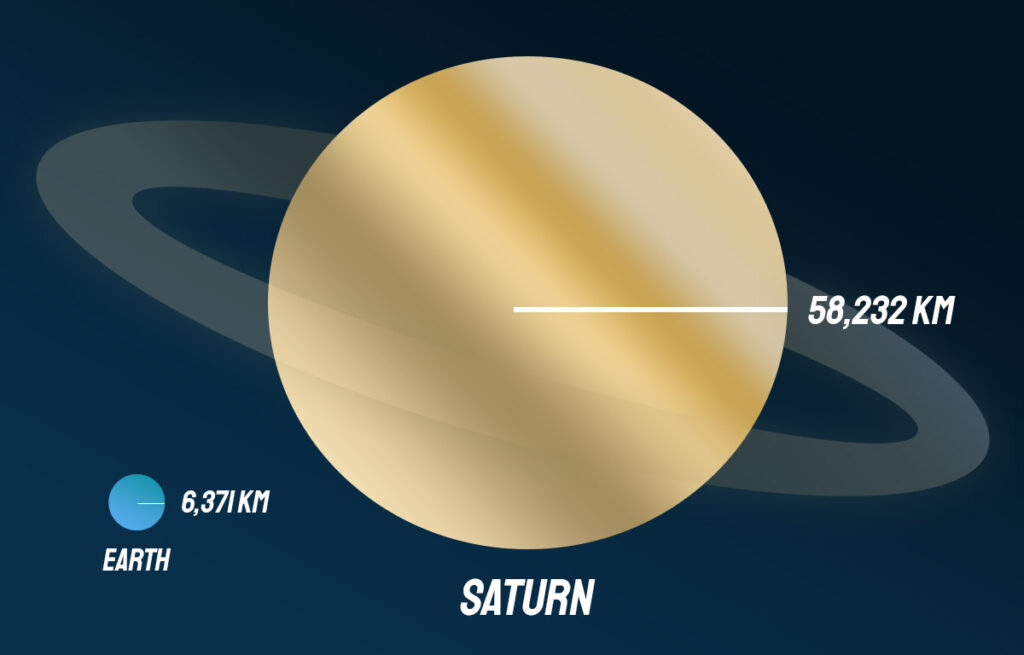
Saturn and Earth similarities
- Both planets orbit the Sun
- Both planets are located in the Solar system
- Saturn and Earth formed around the same time, approximately 4.6 billion years ago
- The cores of both planets have a similar, rocky composition.
- Both planets have atmospheres
- The gravity of Earth and Saturn is very similar, in fact, at the equator, Saturn’s gravity is even lower than Earth’s. This sounds a bit strange because Saturn is so big. But it is a result of Saturn being mostly made out of gas and having a much lower density.
- Saturn and Earth have almost the same albedo. The albedo is a measure of a planet’s reflectiveness against light. This means that if the Sun were at the same distance from both, they’d be almost equally bright.
- Both planets have strong magnetic fields and magnetospheres thanks to their cores. This is why Saturn also has aurorae (“northern lights”) in its poles that have even been captured by the Hubble.
- Both planets have natural satellites (moons).
- The two planets have clouds. In fact, all the outer layer that we see from Jupiter is just clouds swirling very fast.
Saturn and Earth differences
- Earth is considered an “inner” planet in the Solar system. Saturn is an “outer” planet. This division is made by the asteroid belt between Mars and Jupiter.
- Earth is located in the habitable zone of the Solar system. Saturn isn’t. The habitable zone is the area around a star where planets can support liquid water on their surface.
- Earth is the most dense planet in the Solar system. Saturn is on the opposite side and it is the least dense.
- Besides their cores, Earth and Saturn have very different compositions.
- The atmospheres of both planets are very different. Earth’s is mostly made out of nitrogen and oxygen while Saturn’s is made out of hydrogen and helium.
- Earth has a rocky, solid surface, Saturn is a gas giant and doesn’t even have a surface. If a ship were to fall into Saturn (assuming it could withstand the extreme temperatures and pressure), it would sink all the way into the planet’s core.
- The size of both planets is very different. Saturn’s diameter is 9.1 times larger than Earth’s.
- Earth can support life. Saturn can’t.
- Earth has continents and oceans. Saturn can’t have any since it doesn’t have a surface.
- Saturn is a lot colder than Earth. The average temperature on the outer layers is -140°C (-220°F). Earth’s average temperature on the surface is 14°C (57°F)
- Earth is much more dense than Saturn. As a matter of fact, Saturn is the less dense planet in the Solar system. This is why gravity on Saturn isn’t as strong as you’d believe.
- Saturn orbits the Sun very slowly. Earth moves almost three times as fast.
- On the other hand, Saturn rotates extremely fast. Despite its huge size, it takes only 10.5 hours to complete a full rotation (a day).
- When looked at from space, Earth is blue with some brown and white because of the land and clouds. Saturn is yellow, orange, and brown.
- Saturn has multiple rings surrounding it. Even though it is not the only planet that has rings, it has the most prominent ones. Earth doesn’t have rings.
- Because of its size, Saturn has many more natural satellites (moons) than Earth. The current count is at 145 moons but more are being discovered every few years. Earth only has one moon.
Related
If you want to learn more about Saturn and its relation with Earth, check out these other posts.
Summary
- Saturn and Earth have similar core composition, gravity, and were formed around the same time.
- Saturn and Earth are very different in size, atmospheric composition, orbital speed, and rotation, among other things.
- The differences between both planets are due to their position in the solar system as well as other factors.

